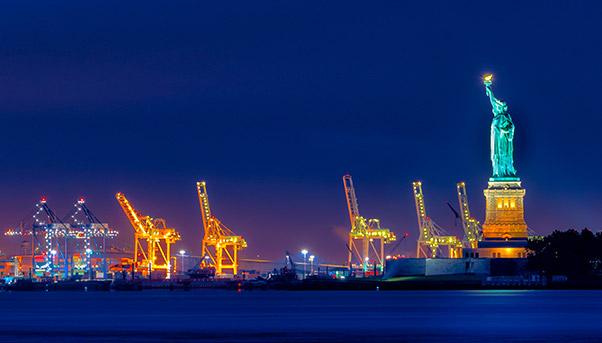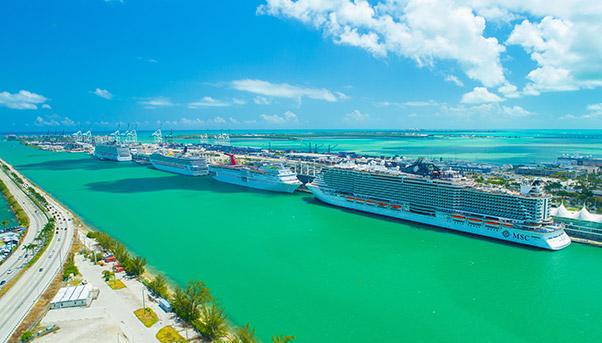
Anyone travelling along the U.S. coast on the Gulf of Mexico, from Corpus Christi in Texas to the Everglades in Florida, comes across a trail left behind by huge bulldozers and tall cranes. It marks the competition between ports to win business from the new generation of super-large ships. The race, which involves also Georgia, the two Carolinas and goes up the coast as far as Baltimore in Maryland, has been triggered by the opening of the new the Panama Canal.
The new waterway between the Atlantic and the Pacific oceans, whose construction was carried out by a European consortium led by Salini Impregilo, is about to celebrate its first two years of activity, going from one record to another. At the end of March, for example, the new canal marked the milestone passage of 3,000 New Panamax, ships weighing over 12,000 tons and about 400 metres long, travelling through the new locks of the Central American isthmus. A result that exceeded the most optimistic forecasts and that put even more emphasis on the need for new infrastructure at U.S., with billion-dollar investments on land and at sea.
The cargo aboard these 3,000 super ships also points to where the funds for the new port facilities should be allocated. Some 53% comes from the container sector, 28% from oil tankers, and 11% from the transport of liquefied natural gas (LNG). The rest is spread among other maritime categories with a quota — today limited to 3% but growing rapidly — for giant cruise ships.
Ports adapting to new super ships
U.S. ports are re-working their credentials in light of the larger
size of these ships. They are asking their respective states for funds
and adjusting their services to customers in terms of operational
efficiency and connection with air and land transport systems.
The immediate return of these billion-dollar investment campaigns is
being measured on the docks of Panama. At the beginning of May, for
example, the Sakura ship passed through the new locks, opening a new
trade route with Japan. The destination of the ship, which travelled on
behalf of Kansai Electric Power, was the Dominion Cove Point terminal,
recently inaugurated in Maryland, south of Baltimore.
This port in Maryland is the second LNG port linked to Panama
after Sabine Pass, which extends along the strip of water that separates
Louisiana from Texas. In the first part of the year, the
Panama Canal increased its management capacity for LNG ship traffic.
Estimates are for a 50% annual growth. Sabine Pass is owned by Cheniere
Energy, which is developing a little further to the east in Corpus
Christi a production and distribution project able to change the gas
supply map in the southern United States where Texas already holds the
record for production with almost a third of the total.
This is an element of considerable importance, given that ratings
agency Standard & Poor’s in late 2017 ranked the United States as a
net exporter of natural gas. So it is no longer just an importer.
According to the U.S. Energy Information Administration, the United
States produces 25% of the world total, a market that from the current
$100 billion is expected to reach $300 billion by 2030.
Sabine Pass and Dominion Cove Point will be joined by Cameron
(Louisiana), Elba Island (Georgia) and Freeport (Texas) in the coming
months. The construction of new infrastructure for natural gas
should boost U.S. production to third place, behind Australia and Qatar,
with consumption growing in Asian countries, thanks also to faster
navigation through the new Panama Canal.
Development plans for U.S. ports
U.S. port authorities have not been idle. One year after the opening of the new Panama Canal on June 26, 2016, nine ports between the east and west had already allocated investments to increase the depth of their basins and to purchase the new container lifting cranes required by the new ships.
The first of the four Neo-Panamax cranes delivered to the port of Savannah, Georgia, has been operational since the end of March, bringing the total number of cranes for loading and unloading containers to 27. “It’s more than any other single terminal in the nation. Georgia intends to stay a step ahead of market demand,” said the Executive Director of Georgia Port Authority Griff Lynch.

The Garden City Terminal, according to the Port Authority of Georgia,
is the largest single container terminal in the Western Hemisphere, and
will receive six more New Panamax cranes by 2020, bringing the fleet to
36. This will allow the port to move almost 1,300 containers per hour
on a single dock.
The greater the numbers involved, the more important becomes the race to
secure first place in some special ranking in the United States. With
370,000 new jobs and $84 billion in revenue it is not hard to
understand the benefit of each crane for the local economy.
From Port Canaveral in Florida to Wilmington in North Carolina, each
port tries to win as many medals as possible and displays them with
pride. Florida is considered the world capital of cruises — with the
first three places in the ranking for trip duration — so much so as to
be chosen as headquarters by the main companies in the sector. The ports
of Miami, the Everglades (Fort Lauderdale) and Cape Canaveral dominate,
followed by other Florida ports in the top 10 in the world, those of
Tampa Bay, Palm Beach, and Jacksonville.
The Port of Miami is the first port in the southern United States to have the capacity to host the New Panamax.
Thanks to an infrastructure project of over $1 billion, the port basin
has reached the magical number of 52-feet deep imposed by the draft of
the giant ships that pass through the Panama Canal. In redesigning the
port, Miami-Dade County also built a fast access tunnel to the motorways
around the city, new rail links for container transport and access
routes to the airport.
Port infrastructure is the driving force behind other connections
also in Fort Lauderdale, whose Port Everglades holds the first place for
revenue from commercial ship ($162 million in 2017), by volume of
containers (over a million TEUs) and for shipment of exports, with over
$12 billion a year to its credit.
In Jacksonville the list of projects still to be assigned is long; same
in Tampa, the largest port in the United States by commercial area
available for new infrastructure; and in Jacksonville, whose JaxPort is
the largest port of call for military cargo and the most important hub
for car transporters.
Alliances between big players to control the seas
The higher stakes of the new routes through Panama are driving new alliances to create mega consortia aggregating big shipping companies in full merger and acquisition fever. It is a demanding but certain way of fulfilling the expectations of U.S. port authorities to have more and more customers. The most important are the Alliance (with partners such as Hapag-Lloyd, NYK, K Line, Yang Ming), the Ocean Alliance (CMA CGM, China Cosco) and the 2M Alliance (Maersk, MSC). These three alliances have already covered three quarters of the global container market.
Given this context of growth, the Association of American Port Authorities (AAPA) has asked Congress and the Trump administration to approve a modernisation and development programme that requires investments in infrastructure for $66 billion during the next 10 years. Both on the waterside, where the AAPA says $33.8 billion is needed to improve and maintain deep-draft navigation channels, and on the landside with another $32.2 billion to rebuild roads, bridges, tunnels and port infrastructure. According to the AAPA, the activity of seaports supports 26% of the U.S. economy. A figure that, with current growth rates, may already be too small.

